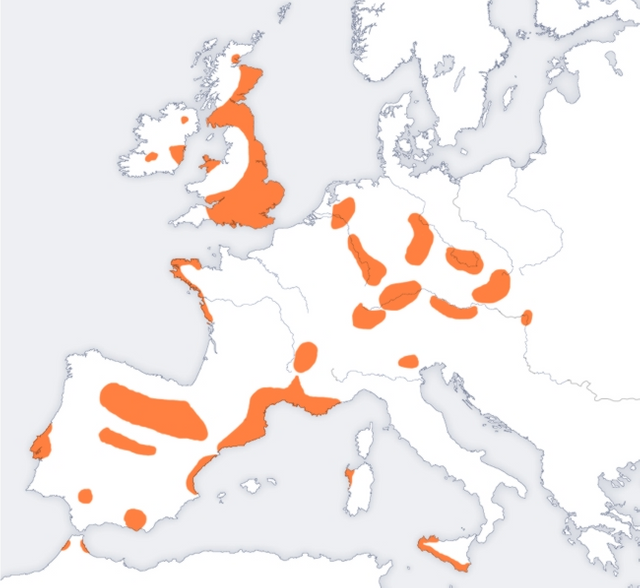What I learnt this week 11: Migrating Germans, Retrocausal quantum time travel jargon, Social Sharks, Shipping Storms, Antarctic Cave Dwellers and CRISPR flowers. Quite a week!
Monday: Bell Beaker Women

Monday's news struck me as quite bizarre, and in fact the opposite to what I would have expected.
Around the Stone age/Bronze age transition period 4,000 years ago, there was an 800 year period (!) in which human females would migrate from Bohemia and Central Germany to Augsburg in Germany, while the men stayed put.
Isotopic and genetic analyses showed that the vast majority of women in Augsberg were not from there originally and could have led to a comparatively rapid development of new technologies of the time by exchanging cultural objects and ideas. It would also have been a useful boost in genetic diversity, since we all know the human race has had a substantial... Game of Throne-esque history.
Burials of these outsider women were no different from local populations, which also indicated that they integrated into their new homes without issues.
The study doesn't go into any speculation as to why this 'patrilocal' system occurred for such a lengthy time, and it's not the most comprehensive study genetically speaking, but a fascinating addition to what is called 'bell beaker culture', which is a widely spread archeological culture across western Europe.

Tuesday: Quantum Time Reversal
Yeah this one sounds clickbaity and fake, as is 90% of stuff on the internet that utilises the word 'quantum'. But this is a very real possibility in the theoretical world of Quantum Physics.
This theory does a pretty good job explaining some probleme we intuitively have with the world of Quanta, specifically Quantum Entanglement.
Named retrocausality, the idea here is that particles that obey the laws of quantum physics may be able to travel backwards in time.
Let's take a step back. Quantum theory is very different to Classical theory, in that it tends to deal with probabilities rather than solid, known numbers and data. Where we can identify and locate the exact position of a planet for example, we cannot do so with these particles because they are in multiple states simultaneously until we observe it, so we can only get a kind of fuzzy idea of what's going on. This is called superposition
That doesn't make this a speculative science, however, since all our GPS technology among other things depends on it. But I won't pretend to understand the ins and outs. As a rule of thumb, if you think you understand whatever the hell I'm talking about, you don't.
Regardless, according to Huw Price, this superposition is very real, and because the science of the very small need not obey the laws of Thermodynamics like classical theory, and particles are typically in multiple superpositioned states, they could indeed be in different positions along the dimension of time as well as the traditional three dimensions.
When we observe the particle, breaking its super position or 'wave function' or whatever, it could alter the state it was in in the past.
So this is where we get to Quantum Entanglement. Einstein famously called this 'spooky action at a distance' and even he felt uncomfortable about it.
Essentially, one particle can instantly change the state of a second, entangled particle simultaneously, regardless of distance. The problem here is that it breaks the universal speed limit of light.
But as I said, we depend on this science in order for our technological world to function as it does today. So what gives?
This theory could help explain this problem, because it allows particles to go back in time. If two previously entangled particles are 20 lightyears away now, they were together at some point in the past. So rather than have information travel beyond the speed of light, these particles simply skip through the dimension of time to a year when they were within range and change their combined state there.
It's pretty wild, and certainly fringe science, but it does do a good job, apparently, of answering some tricky questions in the field of Quantum theory.
It does not mean we will one day be able to time travel though. Remember, we still live in a macroscopic, classical-theory world. We ain't particles. Still, pretty crazy.
If you want a proper explanation of this mind-boggling idea, Read More Here
Wednesday: Social Sharks
This one caught my attention because I love seeing familiar traits in other animals as in humans, and sharks are a particularly distant relative.
Even so, it appears the social lives of sharks are rather similar to our own. Researchers have discovered, after some gruelling effort and time, that sharks tend to hang around with those of the same sex and size as themselves.
Tribalism, anyone?
I can just imagine the little nerd shark getting rejected from the big boy group, only to find the other reject shark geeks and never be happier that he feels like he belongs.
It's actually quite astonishing in this case. The paper explains that the Port Jackson sharks the scientists studied are quite small, yet with huge migration patterns. Even so, the same sharks tend to return to the same reef every year with phenomenal accuracy, so it stands to reason that they start to develop relationships with each other.
The use of tags was of course the simple answer to keep a log on this, but just tagging isn't enough. I mean, blue whales are the largest, bulkiest creatures in the history of earth, but their lives are still a mystery in the vast void of the oceans.
So a bunch of receivers were set out along migration paths which go off when the sharks' acoustic tags are within range, and then it's simply a case of joining the dots.
This has more useful applications than first meets the eye, giving more insight into general behaviour, migration tendencies and even the spread of disease and our own cultural perception of sharks.
So when you see those videos of mass groups of sharks stalking the reefs, realise that it isn't random - they're buddies!

Thursday: Ship-induced Storms
This is one of those things us normal people could never even consider as a thing. Ship exhaust fumes and thunderstorms just don't seem related in any way.
But it turns out the storms that fall over two of the busiest shipping lanes in the South China Sea and the Indian Ocean are twice as strong as ocean just outside of the shipping lanes in the same climates, with double the number of lightning strikes.
This study concludes that the aerosols from ship exhausts make the droplets in clouds break up into smaller particles, which allows them to float higher into the atmosphere and turn into ice. With smaller and more numerous ice particles colliding into each other, more electrification occurs encouraging more lightining as a way to neutralise the charge.
In light of the recent trilogy of hurricanes in the US, it's interesting to see one of the most direct observations of human activity affecting and intenseifying storms on a continual basis.
Although this is really strong evidence of our direct influence on climate, it's unlikely to be something up for consideration, given that these shipping lanes alone are responsible for $5 trillion in trade a year.

Friday: Antarctic Cave Dwellers
The Antarctic has a lot of secrets left to be unlocked, and if you read my previous post about caves, you'll know that they are some of the most unexplored habitats on Earth. Combine the two, and you get some pretty lucrative secrets.
As it turns out, an extensive system of caves has been discovered deep within the active volcano Erebus in Antarctica.
There, Ceridwen Fraser explains that there are traces of DNA from moss, algae and even small animals - Some of them never seen before.
This could be the next place to search for new life; it isn't that cold within the caves, being inside a volcano and all. The researchers were comfortable wearing just a t-shirt as they explored.
Additional: Crispr Flowers
For those who don't know, CRISPR is essentially a modern gene-editing technology, and a bunch of researchers in Japan have managed to change the Japanese Morning Glory flower from a deep, luscious violet colour to a boring white.
Pretty cool, eh?

Basically, they targeted a single gene in the flower (DFR-B) and encoded an enzyme responsible for the colour of the flower's stems, leaves and flowers. This was a testament to the improved technological virtuosity of CRISPR, now being able to pick a single gene from a whole mess of genes in order to accomplish a singular task.
This achievement is also important for educating the masses about the safety of CRISPR's abilities to cut and copy specific parts of strands of DNA, as well as using it to confirm functions of genes.
Still, it doesn't do much to calm the nerves about a dystopian future where the aristocratic bourgeoisie genetically enhance their lineage while the working class have to live with their crappy, regular genes until we split into two humanoid species like that book I read one time.

So there you have it. Lessons learnt: Be nice to sharks, stop trading trillions of dollars of stuff, beware of the future dystopia and stop being racist. That's what I got out of it, anyway. I didn't learn anything from Tuesday. I just got confused.
Image Sources:
Female Skeleton
Bell Beaker Migration
Shipping GIF
SteemSTEM GIF made lovingly by @foundation!

There is more to life than increasing its speed.
- Mahatma Gandhi
good post

@abdelhamidtsouli
Very nice!
All look like very interesting headlines. I'll have to bookmark this and add them all to my to-read list :)